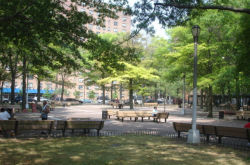Livonia Park
Livonia Playground
This park takes its name from the former Russian province of Livonia. Baltic and Finnish tribes occupied the province throughout the 13th century, united under the rule of the Livonian Knights. The province, contested at various times by Poland, Russia, and Sweden, is now home to the nations of Latvia and Estonia.
Named by 12th century Germans after the Liv people, a Finno-Ugric tribe occupying the area between the mouths of the Dvina and Guaja Rivers, Livonia expanded in the 13th century when it came under the rule of the Livonian Knights. A German military and religious order organized in 1202 under Bishop Albert of Livonia, this band of conquerors wore white robes with red crosses and carried swords. After defeating the Livs, Ests, and Letts, the Knights unified the land of these tribes and settled there, calling their territories Livonia and Courland. In 1237 they merged with the Teutonic Knights (although they continued as a separate state) until the dissolution of the Teutonic Order in 1558. This independence was short-lived, however. In 1561 the Livonian Knights disbanded.
Following the dissolution of the Livonian Order, their land was divided between Poland, Russia, and Sweden. The southwestern part of the province, known as Courland, became a Polish fief. Latgale in the southeast and centrally located Vidzeme became part of Poland proper. Sweden controlled the northern portion of Livonia, known as Estonia, and acquired Latgale from Poland in 1629. Under Peter I (1672-1725) of Russia, the Swedish portion of Livonia was conquered in 1710 during the Northern War and retained at the Peace of Nystad in 1721.
Russia gained Latgale in 1772, and by 1775 again unified the former Livonia, which officially became a Russian province in 1783. The October Revolution of 1917 in Russia brought the creation of a communist state, and Latvia and Estonia, the two countries contained within the Livonian Province, declared independence in 1918. Much like the state of the Livonian Knights centuries earlier, the independence of Latvia and Estonia was brief. The Soviet Union set up puppet governments in both countries, forcefully annexing them as part of the Stalinist war effort in 1940. During World War II (1941-44), both German and Soviet military forces occupied the two nations. Latvia and Estonia did not gain independence until the Soviet Union’s collapse in 1991.
This site is located between Powell and Junius Streets and Dumont and Livonia Avenues in the Brownsville section of Brooklyn. Parks received Livonia Playground as a gift from the New York City Housing Authority on August 7, 1969. The playground contains a lush sitting area with many trees shading the benches, five game tables, and drinking fountain. Although there are many grassy spaces, a pattern of red and white granite paving stones add color to the playground, and a wrought iron fence bounds the entire space.
Check out your park's Vital Signs
Clean & Safe
Green & Resilient
Empowered & Engaged Users
Share your feedback or learn more about how this park is part of a
Vital Park System

